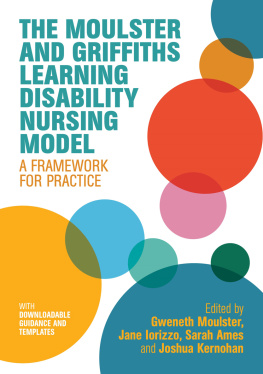The Garden of Delights
THE MIDDLE AGES SERIES
Ruth Mazo Karras, Series Editor
Edward Peters, Founding Editor
A complete list of books in the series
is available from the publisher.
The Garden of Delights
Reform and Renaissance for
Women in the Twelfth Century
Fiona J. Griffiths

Winner of the American Society of Church
Historys Frank S. and Elizabeth D. Brewer Prize
Publication of this book has been aided by a grant from the Medieval Academy of America
Copyright 2007 University of Pennsylvania Press
All rights reserved
Printed in the United States of America on acid-free paper
10 9 8 7 6 5 4 3 2 1
Published by
University of Pennsylvania Press
Philadelphia, Pennsylvania 19104-4112
Library of Congress Cataloging-in-Publication Data
Griffiths, Fiona J.
The garden of delights : reform and renaissance for women in the twelfth century / Fiona J. Griffiths.
p. cm.(The Middle Ages series)
ISBN-13: 978-0-8122-3960-7 (cloth : alk. paper)
ISBN-10: 0-8122-3960-1 (cloth : alk. paper)
Includes bibliographical references (p. ) and index.
1. Herrad, of Landsberg, Abbess of Hohenburg, ca. 11301195. 2. Hortus deliciarum. 3. Monastic and religious life of womenGermanyHistoryMiddle Ages, 6001500. 4. Women in ChristianityGermanyHistoryMiddle Ages, 6001500. 5. Christian womenReligious lifeGermanyHistory12th century. 6. GermanyChurch history8431517. I. Title. II. Series.
BX4210 .G75 2007
271.90094309021dc22 2006045670
To Ronald
Contents
Introduction
During the Last Quarter of the twelfth century, Herrad (d. after 1196), abbess of the Augustinian monastery at Hohenbourg in Alsace, oversaw the production of what was to become one of the most famous of illuminated manuscripts: the Hortus deliciarum or Garden of Delights. A work of compilation, the Hortus comprised a rich selection of texts and images, skillfully woven together into a coherent and carefully structured presentation of salvation history. More than eleven hundred textual extracts, drawn from Christian authors from the early Fathers through the late twelfth century, appeared within an organizational framework defined by the manuscripts ambitious visual cycle. The result, a grand synthesis of word and image, is an extraordinary monument to the spiritual and intellectual culture of a female monastic community at the close of the twelfth century.
This magnificent manuscript, along with all the treasures of the Strasbourg library, was destroyed in the Prussian siege of August 1870. One of the most ambitious and splendid manuscripts of the middle ages is irretrievably destroyed, lamented Rosalie Green of the Princeton Index of Christian Art.of the wholefor the first time since the manuscript was destroyed over a century ago.
The reconstructed Hortus provides a valuable witness to the culture of an otherwise little-known and little-celebrated monastic community during the last decades of the twelfth century. That this community was a womens community and the Hortus uniquely a womens book only adds to its intrigue: the Hortus was the product of a female mastermind and likely also the work of female scribes and artists. The purpose of the manuscript enhances its significance. Since it was never copied during the medieval period and seems not to have been known beyond Hohenbourg until the Renaissance, the Hortus was most likely intended primarily or even exclusively for domestic use: the education of the women of the community. Herrad herself confirms her authorship of the manuscript and intentions for it in her prologue. Describing herself as a bee inspired by God as she gathered the texts of the Hortus from the various flowers of sacred Scripture and philosophic writings, Herrad dedicated the work to the women of her community with the hope that they would find pleasing food and spiritual refreshment in its honeyed dewdrops (HD no. 2). May this book be useful and delightful to you, she wrote to them, May you never cease to study it in your thoughts and memory (HD no. 1).
The particular circumstances of the production and reception of the Hortus at Hohenbourg make it especially useful as a witness to the religious life for women in a period of tremendous spiritual enthusiasm. During the eleventh and twelfth centuries, growing numbers of men and women converted to the religious life, abandoning the world and all its temptations for the rigors of the monastery. Inspired by the rhetoric of church reform, as well as the teaching of itinerant preachers, these women and men sought a life of greater faithfulness to the apostolic example than was thought possible within the secular sphere. Their conversions prompted a surge in monastic foundations: throughout the period new communities were established and old ones revived in order to house the crowds of new converts. The spiritual enthusiasm that inspired them is further reflected in the proliferation of new orders as the traditional Benedictine way of life gave way to include Cistercians, Carthusians, Augustinians, Premonstratensians, Gilbertines, Grandmontines, and others. The period was characterized by lively debates on such issues as the true nature of the apostolic life, the ordination of monks and their pastoral ministry, and the forms of worship permissible within the cloister. Among these many debates, a further question came to the fore, prompted by the increasing and enthusiastic conversions of women: what role did women have in the project of monastic reform? Did the vita apostolica, the apostolic life, include women, and if so how?
The Hortus provides one answer to these questions. When work on the manuscript began, sometime before 1175, Hohenbourg was a recently reformed community of Augustinian canonesses, facing many of the challenges typical of a new refoundation. Although the communitys most pressing material needs seem to have been met by this timeits crumbling buildings had been refurbished and new chapels builtthe women still required spiritual instruction and the consistent presence and pastoral care of a local priest. The provision of pastoral care, the cura monialium or care of nuns, was evidently the source of some concern at Hohenbourg: documents from the period reflect the womens dissatisfaction with the chaplains who served their community. In response, early in her abbacy Herrad established two new foundations for regular canons, both of which were to be dependent on the womens community and to provide spiritual service in its chapels. The Hortus, which was certainly well underway by this time, was a product of a similar impulse: it was designed to meet the communitys need for instruction within the spiritual context of reform, providing its female audience with a wide-ranging theological education while at the same time equipping them with the ability to distinguish between good and bad pastors. In its breadth and theological complexity, the Hortus could supplement, and perhaps even displace, the teaching of Hohenbourgs male priests.
In keeping with these goals, the Hortus presents its audience with a challenging theological curriculum comparable to that which a monk-priest or student in the emerging schools of Paris might have expected. Its texts, which were drawn from a combination of monastic and scholastic works, favor contemporary authors. Herrads major sources included the German Benedictines Honorius Augustodunensis (d. c. 1140) and Rupert of Deutz (d. 1129), authors who composed guidebooks for priests outlining their pastoral and liturgical duties, as well as the Parisian scholar Peter Lombard (d. 1160), whose work became standard reading for male university students. The intellectual currency of the



















